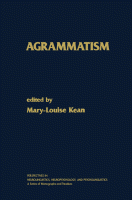Browse content
Table of contents
Actions for selected chapters
- Full text access
- Book chapterAbstract only
1 - Is Agrammatism a Unitary Phenomenon?
HAROLD GOODGLASS and LISE MENN
Pages 1-26 - Book chapterAbstract only
2 - A Multicomponent Deficit View of Agrammatic Broca's Aphasia
ALFONSO CARAMAZZA and RITA SLOAN BERNDT
Pages 27-63 - Book chapterAbstract only
3 - Agrammatism: Structural Deficits and Antecedent Processing Disruptions
YOSEF GRODZINSKY, DAVID SWINNEY and EDGAR ZURIF
Pages 65-81 - Book chapterAbstract only
4 - The Status of the Syntactic Deficit Theory of Agrammatism
MYRNA F. SCHWARTZ, MARCIA C. LINEBARGER and ELEANOR M. SAFFRAN
Pages 83-124 - Book chapterAbstract only
5 - Syntactic and Semantic Structures in Agrammatism
DAVID CAPLAN
Pages 125-152 - Book chapterAbstract only
6 - Two Notes on the Linguistic Interpretation of Broca's Aphasia
LUIGI RIZZI
Pages 153-164 - Book chapterAbstract only
7 - On Parallelism between Production and Comprehension in Agrammatism
HERMAN H.J. KOLK, MARIANNE J.F. VAN GRUNSVEN and ANTOINE KEYSER
Pages 165-206 - Book chapterAbstract only
8 - Agrammatism versus Paragrammatism: A Fictitious Opposition
CLAUS HEESCHEN
Pages 207-248 - Book chapterNo access
References
Pages 249-260 - Book chapterNo access
Author Index
Pages 261-264 - Book chapterNo access
Subject Index
Pages 265-266 - Book chapterNo access
PERSPECTIVES IN NEUROLINGUISTICS, NEUROPSYCHOLOGY, AND PSYCHOLINGUISTICS
Harry A. Whitaker
Pages ibc1-ibc2
About the book
Description
Agrammatism provides an overview of the state of knowledge on agrammatism, typically defined as a disorder of sentence production involving the selective omission of function words and some grammatical endings on words. The book opens with discussions of the diversity of the disorder. This is followed by separate chapters that address primarily questions of syntactic structure in agrammatism, from both linguistic and psycholinguistic perspectives. Within these two gross sections there is no consensus among the conclusions reached by the various authors. However, the position is taken that agrammatism is a disorder distinct from other aphasie disorders of sentence structure. This position is reconsidered in the final two chapters. Because of the intrinsically interdisciplinary character of research on agrammatism, it is hoped that the work presented in this volume will be of interest to linguists and psycholinguists working in areas outside the domain of aphasia, as well as to neurolinguists and neuropsychologists who are already involved in the study of language deficits.
Agrammatism provides an overview of the state of knowledge on agrammatism, typically defined as a disorder of sentence production involving the selective omission of function words and some grammatical endings on words. The book opens with discussions of the diversity of the disorder. This is followed by separate chapters that address primarily questions of syntactic structure in agrammatism, from both linguistic and psycholinguistic perspectives. Within these two gross sections there is no consensus among the conclusions reached by the various authors. However, the position is taken that agrammatism is a disorder distinct from other aphasie disorders of sentence structure. This position is reconsidered in the final two chapters. Because of the intrinsically interdisciplinary character of research on agrammatism, it is hoped that the work presented in this volume will be of interest to linguists and psycholinguists working in areas outside the domain of aphasia, as well as to neurolinguists and neuropsychologists who are already involved in the study of language deficits.
Details
ISBN
978-0-12-402830-2
Language
English
Published
1985
Copyright
Copyright © 1985 Elsevier Inc. All rights reserved.
Imprint
Academic Press
